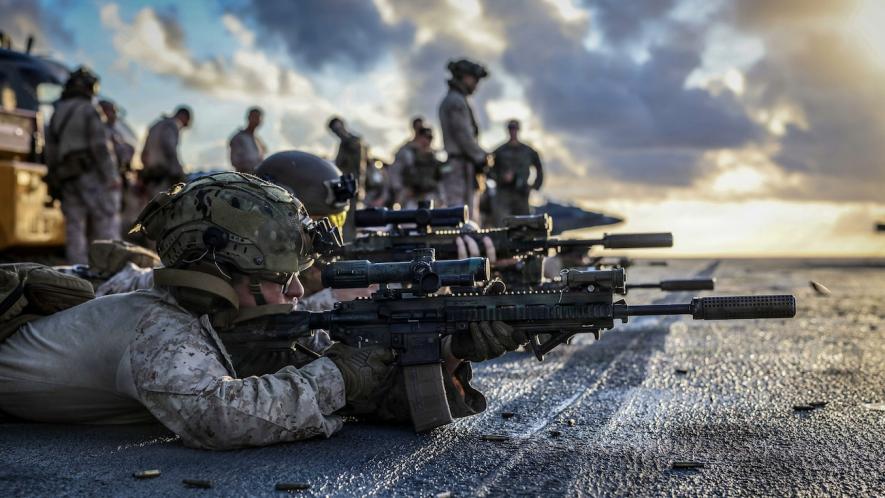US: People go Hungry as Trump Pours Millions to Invade Venezuela

US Marines conduct live-fire training on the flight deck of USS Iwo Jima (LHD 7) in the Caribbean Sea as part of the SOUTHCOM's deployment. Photo: US Marines / X
Lee en español aquí
The United States government is in the grips of one of its longest-running funding gaps in history. The ongoing government shutdown has already stretched beyond 30 days and now, the food security of millions of Americans is at risk as the funding to the Supplemental Nutrition Assistance Program (SNAP) is drying up and Trump officials have refused to tap into contingency funds. Approximately 42 million individuals per month rely on SNAP benefits and are set to lose them beginning on November 1.
Yet, while domestic aid faces a severe funding crisis, the Trump administration’s drive towards military escalation against Venezuela, involving the amassing of immense naval resources in the Caribbean, is costing millions of dollars per day. On the morning of October 31, two major US publications, the Miami Herald and the Wall Street Journal affirmed what many have feared: the United States seeks to carry out military strikes within Venezuelan territory, an unprecedented move in the history of both countries.
The administration’s priorities are clear: austerity and hunger for the working class at home, and unlimited military spending for the goal of regime change abroad.
The cost of war: 18 million US dollars per day
A vast US naval force, which the administration claims is for counter-narcotics operations, has been deployed to the waters near Venezuela. The true nature of this deployment is signaled by its composition and cost: it is a force built for invasion. The military escalation is acute and dangerous, marked by the ongoing extrajudicial strikes in the Caribbean and the Pacific and explicit threats of land strikes. So far, at least 60 people have been killed in at least fourteen such attacks since early September. Victims have been confirmed as citizens of Venezuela, Colombia, and Trinidad and Tobago. The administration has accused the victims of being “narcoterrorists” without providing concrete proof. In several cases, their family members have come forward to assert that those killed were fishermen.
The force deployed in the Caribbean includes the sophisticated and prohibitively expensive Gerald R. Ford Carrier Group. The initial procurement cost for the lead vessel which is the world’s largest aircraft carrier, the USS Gerald R. Ford (CVN-78), was approximately USD 13.3 billion. The Carrier Strike Group that accompanies it carries an estimated daily operating cost of between USD 6 million and USD 8 million.
The deployment is further bolstered by warships like the Arleigh Burke-class destroyer USS Jason Dunham, whose daily operating cost is roughly USD 2 million. Additionally, a large amphibious assault ship like the Iwo Jima (a Wasp-class vessel), designed for transporting and deploying thousands of Marines who are part of the naval force, contributes another USD 1 million to USD 3 million per day when deployed.
The estimated total daily operating cost for the US military operations, primarily naval, currently focused on the Caribbean is at least USD 18 million per day. Since its initial deployment in late August, this naval force has already cost the US taxpayer over USD 600 million. This sum will only continue to grow. The deployment and massive expenditure has done nothing to stem the actual flow of drugs into the US while vital domestic food assistance hangs in the balance. The naval force ready to invade Venezuela consumes hundreds of millions while people in the US go hungry.
Escalation and the allure of Venezuelan oil
The military threats are more than a simple show of force; it is an active escalation that has included lethal strikes on vessels in the Caribbean that have already taken dozens of lives. The deployment of the Gerald Ford Carrier Group and the decision to strike military targets on Venezuelan soil represent a qualitative shift, moving beyond sanctions and rhetoric to a direct military intervention.
The primary strategic driver behind this aggression is Venezuela’s massive oil reserves. For decades, control over global energy supplies has been a core element of US foreign policy. President Trump, like Biden and Obama before him, has viewed the socialist government of Nicolás Maduro as a direct obstacle to seizing control of the world’s largest proven oil reserves. By destabilizing the country and installing a compliant, US-backed regime, the administration seeks to secure a strategic foothold in a key global energy market.
The Monroe Doctrine reasserted: geopolitics and hegemony
The current confrontation with Venezuela is not an isolated incident or just about oil; it is a clear example of the broader geopolitical goals of the US in the region. The Trump administration is openly operating under the spirit of the Monroe Doctrine, the 19th-century policy that proclaimed the Western Hemisphere, and specifically Latin America, as an exclusive sphere of US influence.
The goal is to reassert dominance and dictate the political and economic direction of Latin American nations. Venezuela’s resistance to US neoliberal economic models and its alliances with other global powers (including Russia and China) are seen as an unacceptable ideological threat. The naval deployment serves as a blunt instrument to shape Latin American politics, punishing ideological adversaries and sending a clear signal to all neighboring states about the limits of sovereign independence.
The continuous military pressure, backed by devastating sanctions, is designed to choke the country economically and force a political collapse. The deployment of a Carrier Strike Group is the military underpinning of this strategy, ensuring that if economic and political pressure fails, the option of military intervention remains viable.
A question of political will
The juxtaposition of domestic starvation and foreign military aggression is the ultimate indictment of the American political system. On one hand, the administration claims it cannot afford to maintain fundamental safety nets like SNAP, impacting the ability of millions of citizens to feed their families during a government shutdown. On the other, it displays an immediate, unwavering political will to spend USD 18 million every 24 hours to maintain a fleet capable of initiating a regional conflict hundreds of miles from the US border.
The implications are clear: the US government prioritizes its goals of regime change, control of oil, and violent assertion of regional hegemony over the basic human needs of its own citizens. For the working people of the US, the aggression towards Venezuela is not an act of necessity, but a colossal, unnecessary expenditure of resources and lives in service of a dangerous imperial ambition.
Courtesy: Peoples Dispatch
Get the latest reports & analysis with people's perspective on Protests, movements & deep analytical videos, discussions of the current affairs in your Telegram app. Subscribe to NewsClick's Telegram channel & get Real-Time updates on stories, as they get published on our website.
























